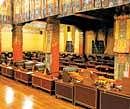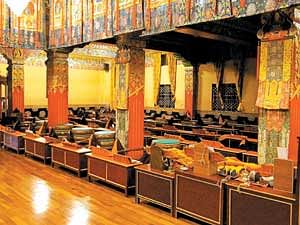

The Tibetan Colony of Bir (pronounced Beed) is a few kms from the Bir Road bus stop on the Mandi-Dharamsala highway straddling the Kangra Valley. We walk towards the colony in the winter drizzle. The snow in the upper reaches has made us change our plans to trek to Billing, a high ridge overlooking Bir from where Para gliders take sail into the Kangra Valley. We settle for the best alternative in the circumstances — a trek to Baijnath the next day on country tracks, passing the Sherabling Monastery on the way. But right now, what we need is some shelter and food. A monk, keeping pace with us, directs us to a lodge in the Tibetan colony. Its the off-season and we get a room with two beds and clean sheets for just Rs 250.
All green
Just across the street is the Gangchen Zompa cafe, a cozy looking place filled with Tibetans at this time. The cafe promises that all the food served is freshly cooked — tomato-egg soup, mutton momos and the tingmo (steamed bread), more than make up for the time they take to arrive. We wake up to a wet morning with a dark cloud cover. After a leisurely breakfast, we start walking towards Baijnath. It is a beautiful road meandering through green fields in open country with no traffic, motorised or otherwise. Soon we reach the cross-country shortcut to Sherabling we have been on the lookout for — a small track veering to the left alongside a tea garden after crossing a big nalah.
What would have been normally a comfortable path has turned into a small stream because of the rain. As we walk down, beautiful vistas unfold; those of tea gardens and wheat fields by small villages. After a while, the path enters a forest. In the distance on a hilltop, there is a lone house. We decide to head for it to get renewed directions for Sherabling. Smoke is coming out from a chimney — a welcome sign indeed. The door opens to our knock, a woman peers out, and without the slightest hesitation invites us — two strangers in jackets and boots, carrying backpacks and umbrellas, to come around to the front door. Over a hot glass of tea, we get acquainted with Mrs Sharma and her son Sunil. While leaving, Sunil walks with us through the forest perhaps a kilometer, until the path ahead becomes clearly visible. We exchange contacts, shake hands, and part. Kangra villagers have the reputation of being simple, straightforward and very hospitable.
The path ahead cuts through a paddy field, crosses a stream, and then ascends a hill. We walk through the field, reach the stream and eventually, after a long detour, we spot the golden shimmer of the roof of the monastery in the distance. Situated right in the middle of a forest, Sherabling turns out to be an amazing place. Its hostels house 600 children, some from Arunachal Pradesh and Sikkim. The monastery is recent in origin — only 17 years old. Inside the main building is a large statue of the future Buddha, who is yet to be born. Norbu, a monk from Arunachal Pradesh, is very patient with us. He has been here for seven years. I ask him if the monks will leave the monastery when their learning is complete. His reply — ‘learning is lifelong and never complete’, leaves me sheepish.
Quaint magic
The interior of the monastery is breathtaking with gleaming polished wooden floors and beautiful arrangements for monks to sit and meditate. Colourful Thanka paintings adorn the walls. There are rooms where visitors can stay and a canteen that offers simple food. We order thukpa — a hot soup with noodles and vegetables, as advised by ‘amma’, a wizened old lady who mans the canteen counter. It turns out to be an excellent choice as it warms us up. Just then, the sun bursts out of the clouds — for the first time in three days, lifting our spirits. Young monks are playing outside throwing snowballs at each other. We still have a long way to go before sundown and it is time to leave.
A narrow road leads from the vicinity of the Sherabling monastery to the village of Bhattu. It is a picturesque village, looks prosperous, clean and washed after the rain. The ubiquitous piles of garbage and plastic, common to tourist destinations are missing here — perhaps a sign that few outsiders pass through.
The houses are set amidst small terraced fields and we can identify wheat, mustard, onions, garlic, and carrots, all in tiny plots. The road winds down along the Binwa river that carries melted snow from the Dhauladhar range of mountains behind us. Walking along an elevated meadow, one gets splendid views of the snow-clad peaks.
We enter the town of Baijnath after crossing a bridge over the Binwa. A little ahead is the 8th century Shiva temple located at a commanding height above the river and offering gorgeous views of the river gorge and the snow peaks in the distance. The temple complex is refreshing, with neat landscaped gardens all around and entrances from several directions.
It is not just a place for prayer; people can be seen taking their evening walk in the complex and relaxing in its parks. Behind the temple, a steep staircase leads down to the river flowing far below. Our trek for today ends at the bus stand, just a couple of minutes away from the Shiva temple. The day has given us far more than anything we could have anticipated when we had set out that rain-drenched morning.